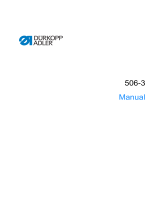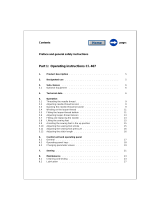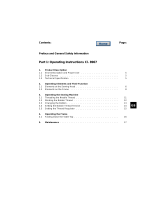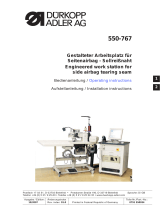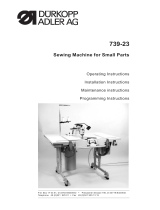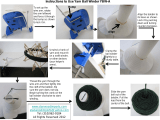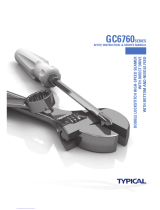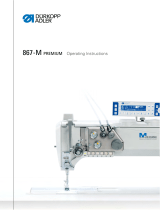Page is loading ...

Contents Page:
Preface and general safety instructions
Part 1: class 69 operating instructions
1. Product description
. . . . . . . . . . . . . . . . . . . . . . . . . . . . 5
2. Designated use
. . . . . . . . . . . . . . . . . . . . . . . . . . . . . . 5
3. Subclasses
3.1 Optional extras . . . . . . . . . . . . . . . . . . . . . . . . . . . . . . . 6
4. Technical data
. . . . . . . . . . . . . . . . . . . . . . . . . . . . . . . 6
5. Operation
5.1 Folding down left-hand half of table plate (MG 56-2 frame only) . . . . 9
5.2 Threading the needle thread . . . . . . . . . . . . . . . . . . . . . . . . 10
5.2.1 Subclass 69-373 . . . . . . . . . . . . . . . . . . . . . . . . . . . . . . 10
5.2.2 Subclass 69-FA-373 . . . . . . . . . . . . . . . . . . . . . . . . . . . . 11
5.3 Adjusting the needle-thread tension . . . . . . . . . . . . . . . . . . . 13
5.4 Opening the needle-thread tensioner . . . . . . . . . . . . . . . . . . . 13
5.5 Winding on the looper thread . . . . . . . . . . . . . . . . . . . . . . . 15
5.6 Fitting the looper-thread bobbin . . . . . . . . . . . . . . . . . . . . . . 15
5.7 Adjusting the looper-thread tension . . . . . . . . . . . . . . . . . . . . 17
5.8 Fitting and changing the needle . . . . . . . . . . . . . . . . . . . . . . 17
5.9 Lifting the sewing feet . . . . . . . . . . . . . . . . . . . . . . . . . . . 19
5.10 Locking the sewing feet in the raised position . . . . . . . . . . . . . . 19
5.11 Adjusting the sewing-foot stroke . . . . . . . . . . . . . . . . . . . . . 19
5.12 Adjusting the sewing-foot pressure . . . . . . . . . . . . . . . . . . . . 20
5.13 Adjusting the stitch length . . . . . . . . . . . . . . . . . . . . . . . . . 20
5.14 Welting . . . . . . . . . . . . . . . . . . . . . . . . . . . . . . . . . . . 21
5.15 Ribbon binder (class 69-373) . . . . . . . . . . . . . . . . . . . . . . . 22
6. Control unit and operating panel
6.1 General . . . . . . . . . . . . . . . . . . . . . . . . . . . . . . . . . . . 23
6.2 Efka VD554KV/6F82AV sewing drive . . . . . . . . . . . . . . . . . . . 24
6.2.1 Control-box buttons . . . . . . . . . . . . . . . . . . . . . . . . . . . . 24
6.2.2 Altering parameter values . . . . . . . . . . . . . . . . . . . . . . . . . 26
6.3 Quick QD554/A51K01 sewing drive . . . . . . . . . . . . . . . . . . . . 28
6.3.1 Operating-panel buttons . . . . . . . . . . . . . . . . . . . . . . . . . . 28
6.3.2 Altering parameter values . . . . . . . . . . . . . . . . . . . . . . . . . 30
Home

Contents Page:
7. Sewing . . . . . . . . . . . . . . . . . . . . . . . . . . . . . . . . . . . 32
8. Maintenance
. . . . . . . . . . . . . . . . . . . . . . . . . . . . . . . 34
8.1 Cleaning and testing . . . . . . . . . . . . . . . . . . . . . . . . . . . 34
8.2 Lubrication . . . . . . . . . . . . . . . . . . . . . . . . . . . . . . . . . 37
9. Optional extras
. . . . . . . . . . . . . . . . . . . . . . . . . . . . . . 38
9.1 HP 11-1 pneumatic rapid stroke adjuster . . . . . . . . . . . . . . . . 38

1. Product description
The
DÜRKOPP ADLER 69
is an all-purpose special sewing machine.
•
Double-lockstitch free-arm machine with underfeed, needle feed and alternating
foot overfeed.
•
Depending on the subclass, a single-needle machine with or without thread clipper
beneath the needle plate.
•
Slim free arm with large passage space and large sewing-foot stroke.
Maximum passage space beneath raised sewing feet: 12 mm (with
sewing-foot-raising knee lever).
•
Small horizontal shuttle.
•
The sewing machine can be supplied with a closed, cut-out or fold-down left-hand
table-plate half. The fold-down version permits the unobstructed manipulation of
large items round the free arm.
•
Smooth, draw-free edging and precision sewing of inner and outer arcs by an
integral follow binder mechanism.
•
Knee-operated pneumatic rapid stroke-adjustment mechanism to switch the foot
overfeed to maximum sewing-foot stroke (optional extra).
2. Designated use
The
69
is a special sewing machine designed to be used to sew light to medium-heavy
materials. As a rule such material consists of textile or synthetic fibres, but it also
includes leather.
These materials are used in the clothing, footwear and leatherwear industries, as well
as in domestic and automobile upholstery.
This special sewing machine can also be used to execute so-called technical seams.
However, the operator must carry out an assessment of the possible dangers (with
which
DÜRKOPP ADLER AG
would be happy to assist), as such applications are
comparatively unusual and they are potentially of enormous diversity. Depending on the
outcome of this assessment it may be necessary to take special safety precautions.
Generally speaking material processed with this special sewing machine must be dry,
its thickness when compressed by the lowered sewing feet must not exceed 7 mm and
it must contain no hard objects, since otherwise the operator of the machine would have
to wear protective goggles (which cannot at present be supplied).
The seam is generally executed with textile-fibre sewing threads up to 30/3 NeB (cotton
yarns), 40/3 Nm (synthetic yarns) or 30/3 Nm (covering yarns) in size. The use of any
other threads must also be subject to an assessment of the risks involved and the
taking of any necessary safety precautions.
The premises in which this special sewing machine is set up and operated must be dry
and well-maintained. If it is to be used in premises which are not dry and
well-maintained, special precautions may be necessary: these must be the subject of
an agreement (see EN 60204-3-1:1990).
As manufacturers of industrial sewing machines we work on the assumption that
personnel working on our machines will be at least semi-skilled, so that they can be
presumed to be familiar with all normal operations and with the dangers inherent in
them.
5

3. Subclasses
class 69-373
: single-needle double-lockstitch free-arm sewing machine with
underfeed, needle feed and alternating-foot overfeed
class 69-FA-373:
as class 69-373, but with electromagnetic thread clipper beneath
the needle plate
3.1 Optional extras
order no. optional extra
FLP 14-2 electro-pneumatic sewing-foot-raising mechanism
pedal-operated.
RAP 14-1 electro-pneumatic bar-tack and sewing-foot-raising mechanism
pedal-operated.
HP 11-1 Pneumatic rapid stroke-adjustment mechanism for the overfeed
knee-operated.
WE-6 Maintenance unit
For pneumatic optional extras.
0797 003031 Pneumatic connection pack
For the pneumatic connection of frames with the maintenance unit
and pneumatic optional extras.
Consisting of connecting hose (length 5 m, diameter 9 mm),
connectors, bands, coupler plug and socket.
9822 510001 Halogen lamp
WALDMANN, with 12V/20W bulb, attached to the upper part of the
machine.
0798 500088 Lamp transformer
For 230V, with mains connector, without switch,
for 9822 510125 and 9822 510001 lamps.
0707 487519 Lamp-attachment set
For 9822 510001 lamp.
4. Technical data
Lc noise-level
workplace-related emission valuein accordance with
indicator:
DIN 45635-48-A-1-KL2
Lc = 81 dB (A)
class: 69-373, 69-FA-373
stitch length: 4 mm
sewing-foot stroke: 3.2 mm
stitch rate: 1700 [min
-1
]
material: double Skai 1.6 mm 900 g/m
2
DIN 53352
6

Needle system: 134
Needle thickness (depending on E no.) [Nm] 110 - 130
Maximum sewing-thread thicknesses:
- cotton [NeB] 30/3
- synthetic endless [Nm] 40/3
- covering yarn [Nm] 30/3
stitch rate:
- maximum [min
-1
]2000
- ex works [min
-1
]1700
maximum stitch length:
- forwards [mm] 5
- backwards [mm] 5
maximum sewing-foot stroke: [mm] 7
maximum passage space beneath raised sewing feet:
- sewing foot raised by lifting lever [mm] 7
- sewing foot raised by knee lever [mm] 12
operating pressure: [bar] 6
rated voltage: 3 x 220-240 V, 50/60 Hz
3 x 380-415 V, 50/60 Hz
dimensions:
- MG 53-3 frame (H x W x D) [mm] 1540 x 1060 x 550
- MG 56-2 frame (H x W x D) [mm] 1560 x 1200 x 600
working height: ...
- MG 53-3 frame [mm] 760 - 850
- MG 56-2 frame [mm] 780
weight (upper part only): ca. [kg] 33
7

5. Operation
5.1 Folding down left-hand half of table plate (MG 56-2 frame only)
When the special sewing machine is fitted with the
MG 56-2
frame the table plate
consists of two parts. The left-hand half 3 can be folded down to permit the
unobstructed manipulation of large items round the free arm.
Folding down the left-hand half of the table plate
–
Turn fasteners 7 and 8 beneath the table plate anticlockwise to unlock the
left-hand half 3 of the table plate.
–
Fold the left-hand half 3 of the table plate down and to the left.
–
Hook shackle 1 onto the pin 2 of the left-hand frame upright.
Folding the left-hand half of the table plate back into place
–
Unhook shackle 1 from pin 2.
–
Lift the left-hand half 3 of the table plate, swivel it to the right and lower it onto
support plates 5 and 6.
The pins 4 in the right-hand half of the table plate must fit into the holes in the
left-hand half 3.
–
Turn fasteners 7 and 8 beneath the table plate clockwise to lock the left-hand
half 3 of the table plate.
7
8
5
3
6
9

5.3 Adjusting the needle-thread tension
Pre-tensioning mechanism (subclass 69-FA-373)
On subclass
69-FA-373
the needle thread needs to be under residual tension for the
thread cutter to function reliably when the main tensioner 2 is open.
This residual tension is created by the pre-tensioning mechanism 1.
The pre-tensioning mechanism 1 also determines the length of the needle-thread end
after the thread has been clipped.
The pre-tension 1 should be set lower than the main tension 2.
–
Adjust pre-tensioning mechanism 1 by turning the knurled nut.
–
After major changes to preliminary tension 1 the main tension 2 should also be
adjusted accordingly.
Main tension
The main tension 2 should be set as low as possible.
The looping of the threads must be in the centre of the material (see fig. a).
With thin material excessive thread tension can cause unwanted gathering and thread
breakage.
–
Adjust the main tensioner 2 so that the stitches are uniform.
5.4 Opening the needle-thread tensioner
Automatic
The main tensioner 2 is opened automatically:
–
when the thread is severed (subclass
69-FA-373
).
–
when the foot is raised (pedal 1 position backwards)
Manual
The main tensioner 2 is opened manually:
–
when the release lever 3 is pressed towards the arm.
The main tensioner 2 remains open for as long as pressure is maintained on the
release lever 3.
–
when the sewing feet are raised mechanically with the knee lever (see chapter 5.9).
–
when the sewing feet are locked in the raised position (see chapter 5.10).
13

5.5 Winding on the looper thread
Caution: danger of injury
Turn off the main switch.
The looper thread may be threaded for winding on only
when the sewing machine is switched off.
–
When winding on for sewing with no underlay material:
arrest the sewing feet in the up position (see chapter 5.10).
–
Thread looper thread as shown in the upper illustration.
–
Wind about 5 coils of looper thread clockwise onto the bobbin core.
–
Place bobbin 3 on bobbin-winder shaft 5.
–
Swivel bobbin-winder lever 4 against the bobbin.
The bobbin-winder wheel 2 is pressed against the V-belt.
–
Adjust tension 1.
The looper thread should be wound on with minimal tension.
–
Sew.
The bobbin-winder lever 4 terminates the process as soon as the bobbin is full.
5.6 Fitting the looper-thread bobbin
Caution - danger of injury
Turn off the main switch.
The looper-thread bobbin may only be changed with the
sewing machine switched off.
Removing empty looper-thread bobbin
–
Turn handwheel until the needle bar reaches its highest position.
–
Pull off cap 6 in the direction of the arrow.
–
Raise bobbin-housing flap 8.
–
Remove top 7 of bobbin housing with bobbin.
–
Remove empty bobbin from top 7 of bobbin housing.
Threading looper thread
–
Place full bobbin 11 in top 7 of bobbin housing:
when the thread is wound off the bobbin 11 must rotate in the direction of the arrow.
–
Draw looper thread down through slit 10 under tensioning spring 9. Pull about 8
cm of looper thread out of the top 7 of the bobbin housing.
–
Replace top 7 of bobbin housing.
–
Close bobbin-housing flap 8.
15

5.7 Adjusting looper-thread tension
Caution: danger of injury
Turn off the main switch.
The looper-thread tension may only be adjusted with the
sewing machine switched off.
Adjusting
brake spring 1 (class 69-FA-373)
On subclass
69-FA-373
the brake spring 1 prevents the bobbin from "running on" when
the machine halts or if the looper thread is wound off spasmodically.
–
Unscrew regulating screw 4 until no tension remains in tension spring 3.
–
Adjust brake spring 1 with regulating screw 5.
The braking force is correctly adjusted if brake spring 1 is about 1 mm above
surface 2.
Adjusting tension spring 3
–
Adjust tension spring 3 with regulating screw 4.
to increase looper-thread tension: turn screw clockwise
to reduce looper-thread tension: turn screw anticlockwise
For stitch formation see sketch a on page 12.
5.8 Fitting and changing the needle
Caution: danger of injury
Turn off the main switch.
The needle may only be changed with the sewing machine
switched off.
–
Turn the handwheel until the needle bar 6 reaches its highest position.
–
Undo screw 7.
–
Pull needle downwards out of needle bar 6.
–
Insert new needle
as far as it will go
into the hole in needle bar 6.
Caution:
When seen from the operating side of the machine the furrow 8 of the needle must
point to the rights(see sketch).
–
Tighten screw 7.
CAUTION:
When a thicker needle is fitted the distance from the
shuttle to the needle must bed corrected (see servicing
instructions).
Failure to comply with this instruction can cause the following faults:
when fitting a thinner needle: faulty stitches, damage to thread
when fitting a thicker needle: damage to the shuttle tip and needle
17

5.9 Lifting the sewing feet
The sewing feet are raised mechanically or electro-pneumatically, depending on which
mechanism is fitted to the machine.
Mechanical sewing-foot-raising mechanism
(with the machine at a halt)
–
Operate knee lever 1.
The sewing feet remain raised as long as pressure is maintained on knee lever 1 [].
Electro-pneumatic sewing-foot-raising mechanism
(when FLP 14-2 or RAP 14-1 are fitted)
–
Push pedal half-way back.
The sewing feet are raised with the machine at a halt.
–
Push pedal all the way back.
The thread clipper is activated and the sewing feet raised.
5.10 Locking the sewing feet in the raised position
The mechanically or pneumatically raised sewing feet 3 are locked in the raised
position with lever 2 (e.g. for the looper thread to be wound on or the sewing foot
changed). Lever 2 is located on the back of the machine arm.
–
With the machine at a halt, swivel lever 2 up.
The sewing feet 3 are locked in the raised position.
–
Swivel lever 2 down.
The sewing feet are no longer locked.
5.11 Adjusting the sewing-foot stroke
The height of the sewing-foot stroke is determined by the position of tension bar 6.
Caution: danger of injury
Turn off the main switch.
The sewing-foot stroke may only be adjusted with the
sewing machine switched off.
Adjusting the sewing-foot stroke
–
Undo nut 4 on the back of the machine arm.
–
Push tension bar 6 into rocker lever 5.
tension bar fully up: maximum sewing-foot stroke (4.5 mm)
tension bar fully down: minimum sewing-foot stroke (2.5 mm)
–
Tighten nut 4.
19

5.12 Adjusting the sewing-foot pressure
Sewing-foot pressure is adjusted with screw 1.
–
to increase sewing-foot pressure: turn screw 1 clockwise
–
to reduce sewing-foot pressure: turn screw 1 anticlockwise.
5.13 Adjusting the stitch length
Caution: danger of injury
Turn off the main switch.
The stitch length may only be adjusted with the sewing
machine switched off.
–
Turn wing-nut 2 anticlockwise as far as it will go.
–
Adjust the desired stitch length with screw 3.
To increase stitch length: turn screw 3 anticlockwise.
The stitch-length handle 4 moves down.
To reduce stitch length: turn screw 3 clockwise.
The stitch-length handle 4 moves up.
–
Tighten wing-nut 2 clockwise.
To sew bar tacks manually (backwards sewing):
–
Swivel the stitch-length handle 4 up as far as it will go (to position "
R
").
The machine sews backwards as long as the stitch-length handle 4 is held up.
2
3
4
1
20

5.14 Welting
The rapid-adjustment welt-guide mechanism with three positions is used to sew welts
between two layers of material. It can be swivelled in or out at the beginning and end of
the seam.
Four welt guides 2 are available (sewing attachments E20 - E23) with welt grooves from
3 to 6 mm.
Caution: danger of injury
Turn off the main switch.
The welt may only be inserted with the sewing machine
switched off.
Inserting the welt
–
Undo screw 1.
–
Feed welt in through welt guide 2.
–
Adjust welt guide 2 to the width of the welt.
The welt must be guided at the sides, but at the same time it must be easy to pull it
through the welt guide 2.
–
Tighten screw 1.
Sewing in the welt
–
Lay the welt between the two layers of material.
–
Pull out ball handle 4 and turn lever 3 as far as it will go to the left (position
P
).
–
Start sewing until the needle has reached approximately the middle of the welt.
–
To continue sewing in the welt pull out ball handle 4 and turn lever 3 to the centre
position (position
S
), where it engages.
–
At the end of the seam pull out ball handle 4 and turn lever 3 to its basic position
(position
0
).
3
4
1
2
21

5.15 Ribbon binder (class 69-373)
Two ribbon-binder sets are available for subclass
69-373
:
sewing attachment E4: for narrow bindings
sewing attachment E5: for broad bindings
Caution: danger of injury
Turn off the main switch.
The ribbon band may only be inserted with the sewing
machine switched off.
Inserting the ribbon band
–
Place the ribbon band on the lower pulley of the reel holder 3.
–
Place upper pulley and pressure spring 2 on reel holder 3.
–
Screw knurled nut 1 onto reel holder 3.
The ribbon band should be kept under slight pressure.
–
Slightly raise the arm cover 6 and swivel it forwards (towards the operating side).
–
Pass the ribbon band between the guide pins 5, through the ribbon guide 4, into
the ribbon binder 8 and under the sewing feet.
–
Swivel the arm cover 6 back into place.
Adjusting the distance of the seam from the ribbon edge
–
Undo screws 7.
–
Adjust the distance of the seam from the ribbon edge as required by moving the
ribbon binder 8.
–
Tighten screws 7.
4 5 6
1
2
3
7
8
22
/








